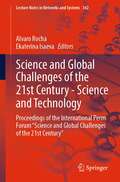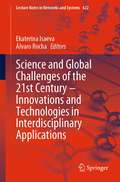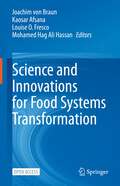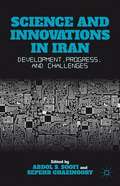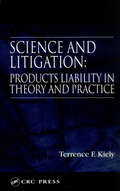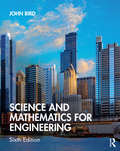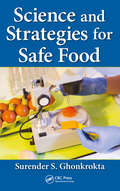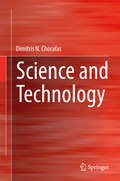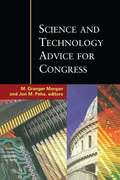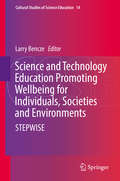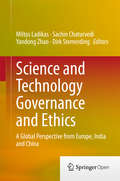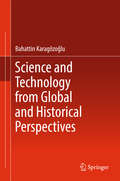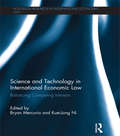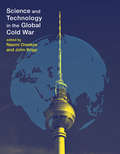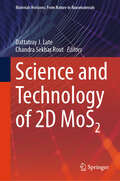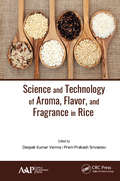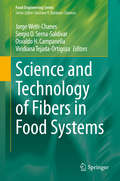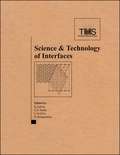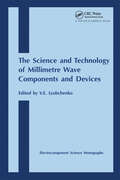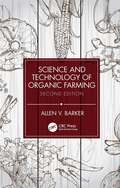- Table View
- List View
Science and Global Challenges of the 21st Century - Science and Technology: Proceedings of the International Perm Forum “Science and Global Challenges of the 21st Century” (Lecture Notes in Networks and Systems #342)
by Alvaro Rocha Ekaterina IsaevaThis book comprises the proceedings of the International Perm Forum “Science and Global Challenges of the 21st Century” held on October 18th – 23rd, 2021, at Perm State University, Perm, Russia. Global challenges, which determine the main trends in the development of social and economic life in the XXI century, require the integration of specialists in various fields of knowledge. That is why the main principle of this edition is interdisciplinarity, the formation of end-to-end innovation chains, including fundamental and applied research, and the wide application of smart innovations, networks, and information technologies. The authors seek to find synergy between technologies and such fields as computer science, geosciences, biology, linguistics, social studies, historical studies, and economics. The book is of interest to researchers seeking nontrivial solutions at the interface of sciences, digital humanities, computational linguistics, cognitive studies, machine learning, and others.
Science and Global Challenges of the 21st Century – Innovations and Technologies in Interdisciplinary Applications (Lecture Notes in Networks and Systems #622)
by Álvaro Rocha Ekaterina IsaevaThis book comprises proceedings of the 2022 International Forum “Science and Global Challenges of the XXI Century”. The main principle of the Forum’s program is interdisciplinarity, the formation of end-to-end innovation chains: fundamental and applied research, technology development, implementation, and wide application of networks and systems. In 2022, the central theme of the forum is innovations and technologies in interdisciplinary applications. The book covers a wide range of knowledge-communication methodologies and effective technologies for processing data in various forms and areas. The book might interest researchers working at the interface of disciplines, such as e-learning, digital humanities, computational linguistics, cognitive studies, GIS, digital geography, machine learning, and others. It can also be a valuable source of information for Bachelor and Master students with open curricula or majors and minors who seek to find a balance between several fields of their interest.
Science and Innovations for Food Systems Transformation
by Louise O. Fresco Joachim Von Braun Mohamed Hag Ali Hassan Kaosar AfsanaThis Open Access book compiles the findings of the Scientific Group of the United Nations Food Systems Summit 2021 and its research partners. The Scientific Group was an independent group of 28 food systems scientists from all over the world with a mandate from the Deputy Secretary-General of the United Nations. The chapters provide science- and research-based, state-of-the-art, solution-oriented knowledge and evidence to inform the transformation of contemporary food systems in order to achieve more sustainable, equitable and resilient systems.
Science and Innovations in Iran
by Abdol S. Soofi Sepehr GhazinooryOver the last two decades Iran has gone through major industrial transformation, in spite of major obstacles in the path of the country's development. This comprehensive book examines the Iranian government's mobilization of resources to develop science and technology, presenting an overview of the structure, dynamics, and outcomes of the government's science and technology policies. It evaluates sectors at the systems level and emphasizes the prominence of government, rather than of the market, in the innovation system of the Iranian economy. Written by authors who are in positions of leadership in the industries they discuss, this book offers an unparalleled look into Iran's current technology achievements.
Science and Litigation: Products Liability in Theory and Practice
by Terrence F. KielyThe question "what is science" has been one of the most vigorously contested legal questions as to what is legally acceptable scientific foundation for the submission of expert opinion in a wide variety of cases, especially in products liability cases. The answer usually lies in the outcomes of past cases as well as objective scientific literature.
Science and Mathematics for Engineering
by John BirdA practical introduction to the engineering science and mathematics required for engineering study and practice.Science and Mathematics for Engineering is an introductory textbook that assumes no prior background in engineering. This new edition covers the fundamental scientific knowledge that all trainee engineers must acquire in order to pass their examinations and has been brought fully in line with the compulsory science and mathematics units in the new engineering course specifications. A new chapter covers present and future ways of generating electricity, an important topic.John Bird focuses upon engineering examples, enabling students to develop a sound understanding of engineering systems in terms of the basic laws and principles. This book includes over 580 worked examples, 1300 further problems, 425 multiple choice questions (with answers), and contains sections covering the mathematics that students will require within their engineering studies, mechanical applications, electrical applications and engineering systems.This book is supported by a companion website of materials that can be found at www.routledge/cw/bird. This resource includes fully worked solutions of all the further problems for students to access, and the full solutions and marking schemes for the revision tests found within the book for instructor use. In addition, all 447 illustrations will be available for downloading by lecturers.
Science and Risk Regulation in International Law
by Jacqueline PeelThe regulation of risk is a preoccupation of contemporary global society and an increasingly important part of international law in areas ranging from environmental protection to international trade. This book examines a key aspect of international risk regulation - the way in which science and technical expertise are used in reaching decisions about how to assess and manage global risks. An interdisciplinary analysis is employed to illuminate how science has been used in international legal processes and global institutions such as the World Trade Organization. Case studies of risk regulation in international law are drawn from diverse fields including environmental treaty law, international trade law, food safety regulation and standard-setting, biosafety and chemicals regulation. The book also addresses the important question of the most appropriate balance between science and non-scientific inputs in different areas of international risk regulation.
Science and Strategies for Safe Food
by Surender S. GhonkroktaFood system has become complex with globalisation and there are stringent requirements from food business operators. In this respect there is a need to bring together aspects of food security, food safety management, food quality management, food analysis and risk analysis. This book focuses on all these aspects hence it would find wide application amongst academia, researchers, food regulators, auditors and consumers.
Science and Technology
by Dimitris N. ChorafasThe aim of this book is to explore science and technology from the viewpoint of creating new knowledge, as opposed to the reinterpretation of existing knowledge in ever greater but uncertain detail. Scientists and technologists make progress by distinguishing between what they regard as meaningful and what they consider as secondary or unimportant. The meaningful is dynamic; typically, the less important is static. Science and technology have made a major contribution to the culture and to the standard of living of our society. From antiquity to the present day, the most distinguished scientists and technologists have been thinkers, experimenters and persons willing and able to challenge "the obvious". Technology develops products and processes based on the breakthroughs of science. If technologists fail to steadily upgrade their skills, tools and methods, they will only be as good as their last design, risking obsolescence. Using practical examples and case studies, this book documents the correlations existing between science and technology, and elucidates these correlations with practical applications ranging from real-life situations, from R&D to energy production. As it is a salient problem, and a most challenging one to our society, power production has been chosen as a major case study. The holistic approach to science and technology followed by this text enhances the ability to deliver practical results. This book is intended for students and researchers of science, technology and mathematical analysis, while also providing a valuable reference book for professionals. Its subject is one of the most debated problems of mankind.
Science and Technology Advice for Congress
by M. Granger Morgan Jon M. PehaThe elimination of the Office of Technology Assessment (OTA) in 1995 came during a storm of budget cutting and partisan conflict. Operationally, it left Congress without an institutional arrangement to bring expert scientific and technological advice into the process of legislative decisionmaking. This deficiency has become increasingly critical, as more and more of the decisions faced by Congress and society require judgments based on highly specialized technical information. Offering perspectives from scholars and scientists with diverse academic backgrounds and extensive experience within the policy process, Science and Technology Advice for Congress breaks from the politics of the OTA and its contentious aftermath. Granger Morgan and Jon Peha begin with an overview of the use of technical information in framing policy issues, crafting legislation, and the overall process of governing. They note how, as nonexperts, legislators must make decisions in the face of scientific uncertainty and competing scientific claims from stakeholders. The contributors continue with a discussion of why OTA was created. They draw lessons from OTA's demise, and compare the use of science and technological information in Europe with the United States. The second part of the book responds to requests from congressional leaders for practical solutions. Among the options discussed are expanded functions within existing agencies such as the General Accounting or Congressional Budget Offices; an independent, NGO- administrated analysis group; and a dedicated successor to OTA within Congress. The models emphasize flexibility--and the need to make political feasibility a core component of design.
Science and Technology Education Promoting Wellbeing for Individuals, Societies and Environments
by Larry BenczeThis edited volume provides theoretical and practical resources relating to the 'STEPWISE' curricular and instructional framework. 'STEPWISE' is the acronym for Science & Technology Education Promoting Wellbeing for Individuals, Societies & Environments. It is a framework for organizing teaching and learning domains in ways that prioritize personal and social actions to address 'critical socioscientific issues' -- that is, controversial decisions by powerful individuals/groups about science and technology (and related fields) that may adversely affect individuals, societies and/or environments. The book contains chapters written by and/or with teachers who have used STEPWISE to guide their instructional practices, as well as chapters written by education scholars who have used a range of theoretical lenses to analyze and evaluate STEPWISE -- and, in several cases, described ways in which it relates to (or could relate to) their practices and/or ways in which the framework might logically be amended. Overall, this book offers educators, policy makers and others with resources useful for arranging science and technology education in ways that may assist societies in addressing significant potential personal, social and/or environmental problems -- such as dramatic climate change, preventable human diseases, species losses, and social injustices -- associated with fields of science and technology.
Science and Technology Governance and Ethics
by Miltos Ladikas Sachin Chaturvedi Yandong Zhao Dirk StemerdingThis book analyzes the possibilities for effective global governance of science in Europe, India and China. Authors from the three regions join forces to explore how ethical concerns over new technologies can be incorporated into global science and technology policies. The first chapter introduces the topic, offering a global perspective on embedding ethics in science and technology policy. Chapter Two compares the institutionalization of ethical debates in science, technology and innovation policy in three important regions: Europe, India and China. The third chapter explores public perceptions of science and technology in these same three regions. Chapter Four discusses public engagement in the governance of science and technology, and Chapter Five reviews science and technology governance and European values. The sixth chapter describes and analyzes values demonstrated in the constitution of the People's Republic of China. Chapter Seven describes emerging evidence from India on the uses of science and technology for socio-economic development, and the quest for inclusive growth. In Chapter Eight, the authors propose a comparative framework for studying global ethics in science and technology. The following three chapters offer case studies and analysis of three emerging industries in India, China and Europe: new food technologies, nanotechnology and synthetic biology. Chapter 12 gathers all these threads for a comprehensive discussion on incorporating ethics into science and technology policy. The analysis is undertaken against the backdrop of different value systems and varying levels of public perception of risks and benefits. The book introduces a common analytical framework for the comparative discussion of ethics at the international level. The authors offer policy recommendations for effective collaboration among the three regions, to promote responsible governance in science and technology and a common analytical perspective in ethics.
Science and Technology for the Conservation of Cultural Heritage
by M. Lazzari M.A. Rogerio-Candelera E. CanoFrom 2nd to 5th October 2012 an International Congress on Science and Technology for the conservation of Cultural Heritage was held in Santiago de Compostela, Spain, organized by the Universidade of Santiago de Compostela on behalf of TechnoHeritage Network. The congress was attended by some 160 participants from 10 countries, which presented a tot
Science and Technology from Global and Historical Perspectives
by Bahattin KaragözoğluThis book provides science and technology ethos to a literate person. It starts with a rather detailed treatment of basic concepts in human values, educational status and domains of education, development of science and technology and their contributions to the welfare of society. It describes ways and means of scientific progresses and technological advancements with their historical perspectives including scientific viewpoints of contributing scientists and technologists. The technical, social, and cultural dimensions are surveyed in relation to acquisition and application of science, and advantages and hindrances of technological developments. Science and Technology is currently taught as a college course in many universities with the intention to introduce topics from a global historical perspective so that the reader shall stretch his/her vision by mapping the past to the future. The book can also serve as a primary reference for such courses.
Science and Technology in Colonial India
by Kamlesh MohanThis book is a significant contribution to the socio-political history of science and technology in India, combining a wholistic perspective with a strong regional flavour. It revolves around two basic issues. First is the role of science and technology in empire-building in Asia, specifically in India, and financing its maintenance through maximum exploitation of its human, natural, agricultural and other resources by launching and executing a number of exploratory projects, termed as ‘field sciences’. Such an imperial focus was undergirded by a crucial objective; the acquisition of hegemony through social control based on intimate knowledge of horizontal and vertical divisions in lndian society around the axes of religion and caste. Formalised as colonial ethnography by the administrators, it was institutionalised as a discipline in the British universities. Second concerns the decoding of the complex response of the Indian intelligentsia including the English-educated as well as the experts and advocates of classical and regional languages which were the key to indigenous knowledge in indigenous sciences, arts and literature.The book also discusses the innovative use of print technology by Arya Samaj in recasting Hindu consciousness and its alternative of seeking historical guidelines in the past.
Science and Technology in International Economic Law: Balancing Competing Interests (Routledge Research in International Economic Law)
by Bryan Mercurio Kuei-Jung NiScience and technology plays an increasingly important role in the continued development of international economic law. This book brings together well-known and rising scholars to explore the status and interaction of science, technology and international economic law. The book reviews the place of science and technology in the development of international economic law with a view to ensure a balance between the promotion of trade and investment liberalisation and decision-making based on a sound scientific process without hampering technological development. The book features chapters from a range of experts – including Lukasz Gruszczynski, Jürgen Kurtz, Andrew Mitchell and Peter K. Yu – who examine a wide range of issues such as investment law, international trade law, and international intellectual property. By bringing together these issues, the book asks how international trade and investment regimes utilise science and technology, and whether they do so fairly and in the interest of broader public policies. This book will be of great interest to researchers of international economic law, health law, technology law and international intellectual property law.
Science and Technology in World History: An Introduction
by Harold Dorn James E. McClellan IIIArguably the best general history of science and technology ever published.Tracing the relationship between science and technology from the dawn of civilization to the early twenty-first century, James E. McClellan III and Harold Dorn’s bestselling book argues that technology as "applied science" emerged relatively recently, as industry and governments began funding scientific research that would lead directly to new or improved technologies.McClellan and Dorn identify two great scientific traditions: the useful sciences, which societies patronized from time immemorial, and the exploration of questions about nature itself, which the ancient Greeks originated. The authors examine scientific traditions that took root in China, India, and Central and South America, as well as in a series of Near Eastern empires in late antiquity and the Middle Ages. From this comparative perspective, McClellan and Dorn survey the rise of the West, the Scientific Revolution of the seventeenth century, the Industrial Revolution, and the modern marriage of science and technology. They trace the development of world science and technology today while raising provocative questions about the sustainability of industrial civilization.This new edition of Science and Technology in World History offers an enlarged thematic introduction and significantly extends its treatment of industrial civilization and the technological supersystem built on the modern electrical grid. The Internet and social media receive increased attention. Facts and figures have been thoroughly updated and the work includes a comprehensive Guide to Resources, incorporating the major published literature along with a vetted list of websites and Internet resources for students and lay readers.
Science and Technology in the Global Cold War (Transformations: Studies in the History of Science and Technology)
by John Krige Naomi OreskesInvestigations of how the global Cold War shaped national scientific and technological practices in fields from biomedicine to rocket science.The Cold War period saw a dramatic expansion of state-funded science and technology research. Government and military patronage shaped Cold War technoscientific practices, imposing methods that were project oriented, team based, and subject to national-security restrictions. These changes affected not just the arms race and the space race but also research in agriculture, biomedicine, computer science, ecology, meteorology, and other fields. This volume examines science and technology in the context of the Cold War, considering whether the new institutions and institutional arrangements that emerged globally constrained technoscientific inquiry or offered greater opportunities for it.The contributors find that whatever the particular science, and whatever the political system in which that science was operating, the knowledge that was produced bore some relation to the goals of the nation-state. These goals varied from nation to nation; weapons research was emphasized in the United States and the Soviet Union, for example, but in France and China scientific independence and self-reliance dominated. The contributors also consider to what extent the changes to science and technology practices in this era were produced by the specific politics, anxieties, and aspirations of the Cold War.ContributorsElena Aronova, Erik M. Conway, Angela N. H. Creager, David Kaiser, John Krige, Naomi Oreskes, George Reisch, Sigrid Schmalzer, Sonja D. Schmid, Matthew Shindell, Asif A. Siddiqi, Zuoyue Wang, Benjamin Wilson
Science and Technology of 2D MoS2 (Materials Horizons: From Nature to Nanomaterials)
by Dattatray J. Late Chandra Sekhar RoutThis book provides a comprehensive overview of the current state of the art in 2D MoS2 materials synthesis, properties, and mimics of various applications. It covers a brief history of MoS2, its origin, properties, and applications in various fields such as optoelectronics, nanoelectronics, catalysis, energy storage and generation, nano-lubricants, etc. The book focuses on novel synthesis approaches of bulk and nano-MoS2. It includes various innovative characterization techniques, different approaches to surface functionalization, strengths, and limitations of these materials along with their different properties. Additionally, it addresses the enhancing the properties of the materials using heterostructure formation with other materials. The topics covered in the book are of vital importance in a wide range of modern and emerging layered materials employed in most industries, academics, healthcare, food, environment, and research institutes. The book brings together numerous experts in the field of MoS2 on novel synthesis, usual properties, and applications of this modern material to address fundamental issues prevailing in this thematic domain. This book is recommended for physics, Chemistry, materials science and engineering departments and as a reference for researchers in the field.
Science and Technology of Aroma, Flavor, and Fragrance in Rice
by Deepak Kumar Verma Prem Prakash SrivastavWith contributions from a broad range of leading researchers, this book focuses on advances and innovations in rice aroma, flavor, and fragrance research. Science and Technology of Aroma, Flavor, and Fragrance in Rice is specially designed to present an abundance of recent research, advances, and innovations in this growing field. Aroma is one of the diagnostic aspects of rice quality that can determine acceptance or rejection of rice before it is tested. Aroma is also considered as an important property of rice that indicates its preferable high quality and price in the market. An assessment of known data reveals that more than 450 chemical compounds have been documented in various aromatic and non-aromatic rice cultivars. The primary goal of research is to identify the compounds responsible for the characteristic rice aroma. Many attempts have been made to search for the key compounds contributing to rice aroma, but any single compound or group of compounds could not reported that are fully responsible. There is no single analytical technique that can be used for investigation of volatile aroma compounds in rice samples although there are currently many technologies available for the extraction of rice volatile aroma compounds. These technologies have been modified from time to time according to need, and many of them are helping the emergence of a new form, particularly in the distillation, extraction, and quantification concept. This new volume helps to fill a void in the research by focusing solely on aroma, flavor, and fragrance of rice, helping to meet an important need in rice research and production. Key features of this volume: • provides an overview of aromatic rice from different countries • looks at traditional extraction methods for chemicals associated with rice aroma, flavor, and fragrance • presents new and modern approaches in extraction of rice aroma chemicals • explores genetic engineering for fragrance in rice
Science and Technology of Fibers in Food Systems (Food Engineering Series)
by Jorge Welti-Chanes Osvaldo H. Campanella Sergio O. Serna Saldívar Viridiana Tejada-OrtigozaThis text provides comprehensive coverage of fibers used in food formulations, starting with the understanding of their basic chemical structure and how they are present and organized in the cell wall structure, their physicochemical and functional properties, their impact on the digestive process and their role and preventive action against various chronic diseases including colon cancer. The book focuses on traditional and new fiber rich sources, incorporating an integrated approach in terms of the technological and engineering processes used to obtain and incorporate them in traditional foods, plus their characterization, extraction and modification. The study of processing conditions including the chemical, physical and enzymatic processes of fiber extraction and modification are also covered, including traditional and emerging processing technologies, plus the application of fibers in the development of new products and processes. Science and Technology of Fibers in Food Systems integrates knowledge of fibers from their basic structural and property aspects and the applications of these ingredients to extraction process analysis, modification and feasibility for use at the industry level. The chapters incorporate the physiological aspects related to the consumption of fiber for prevention of serious diseases.
Science and Technology of Integrated Ferroelectrics: Selected Papers from Eleven Years of the Proceedings of the International Symposium of Integrated Ferroelectronics
by Ramamoorthy Ramesh Carlos Pazde-Araujo George W TaylorThe aim of this book is to present in one volume some of the most significant developments that have taken place in the field of integrated ferroelectrics during the last decade of the twentieth century. The book begins with a comprehensive introduction to integrated ferroelectrics and follows with fifty-three papers selected by Carlos Paz de Arauj
Science and Technology of Interfaces, International Symposium in Honor of Dr. Bhakta Rath
by The Minerals Metals Materials SocietyThese proceedings of the 2002 TMS Annual Meeting present contemporary research and developments on interfaces in various materials ranging from advanced nanostructured materials to high Tc superconductors. Attention is given to the effect of interfaces on the properties of advanced materials.
Science and Technology of Millimetre Wave Components and Devices
by V. E. LyubchenkoIn this comprehensive book, all aspects of Millimeter Waves (MMWs) are explored with an emphasis on the fundamental aspects of the associated physical phenomena. Each chapter provides a review of the main aspects of the subject, including: fundamental limitations and prospects of semiconductor device application in MMW radio systems; multi-element
Science and Technology of Organic Farming
by Allen V. BarkerOrganic farming is not only a philosophy; it is also a well-researched science. The second edition of The Science and Technology of Organic Farming presents the scientific basis of organic farming and the methods of application needed to achieve adequate yields through plant nutrition and protection. Organic farming is a scientifically derived method of improving soil fertility to increase agricultural yields with limited chemical inputs. As such, it can meet public demand for reduced chemical inputs in agriculture and play a key role in meeting the needs of a growing world population. The new edition of this highly regarded book gives clear and comprehensive details on how soil fertility can be maintained and how plants can be nourished in organic agriculture. Chapters on soil fertility and plant nutrition explain the chemistry of the plant, the soil, and the soil solution and outline the importance of plant macronutrients and micronutrients. The book offers practical information on using of green manures, composts and lime to maintain soil fertility; introduces methods of tillage of land; provides organic methods of controlling weeds, insects, and diseases; and suggests how food produce can be stored without refrigeration. The text provides information on how to assess and govern the nutritional status of crops and the fertility and condition of soil and presents guidelines, recommendations, and procedures for determining the best fertility recommendations for individual situations. This edition includes an entirely new chapter on hydroponics that explains organic approaches to hydroponic crop production. With a full bibliography of references, this text is a practical guide for anyone interested in organic farming, from farmers and agricultural advisers to teachers, soil scientists, plant scientist, entomologists and students of other biological and environmental sciences.
